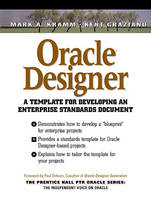
Oracle Designer
Prentice Hall (Verlag)
978-0-13-015343-2 (ISBN)
- Titel ist leider vergriffen;
keine Neuauflage - Artikel merken
PLEASE PROVIDE
There's only one right way to begin an Oracle Designer project: with a detailed enterprise standards document the whole project team can work from - but most developers hate building them. Now, in Oracle Designer: A Template for Developing Enterprise Standards, two leading Oracle experts have done all the hard work! Mark Kramm and Kent Graziano have brought together years of standards-building wisdom, providing easy-to-adapt templates and domain definitions -- and powerful insights for improving systems team development! Learn expert techniques for analyzing, developing, and "blueprinting" any enterprise application. Master proven processes for building and improving your own standards documents. Kramm and Graziano's proven standards, naming and diagram conventions are all on the accompanying CD-ROM in Microsoft Word document templates and Designer archive files that are easy to adapt and share. They'll simplify and improve every phase of the development lifecycle.
Mark A. Kramm is President of Palindrome Solutions, Inc., which specializes in Oracle CDM Advantage and Designer training/consulting. He has published many articles in Oracle Developer Magazine and the Oracle Development Tools User Group (ODTUG) Technical Journal and is a regular presenter at national and international conferences. He has been on ODTUG's Board of Directors since 1997. Kent B. Graziano is a Senior Technical Architect for ARIS Corporation in Denver, Colorado, where he leads efforts using Oracle's Designer tool to aid in analysis, design, development, and re-engineering of enterprise systems and data warehouses. He is President of the Oracle Development Tools User Group and winner of the 1999 Chris Wooldridge Award from IOUG-A. He co-authored the successful Data Model Resource Book with Bill Inmon and Len Silverston.
Preface.
Foreword.
1. Standards? We Don't Need No Stinking Standards!
Who Needs Standards Anyway? The Cost of Creating and Implementing Standards. How Can You Use This Book and the CD-ROM? Using the Document as Is. Using Most of the Document. Using Only Part of the Document. Domain Definitions. Where Did These Standards Come From? Assumptions. Overview.
I. OBJECT NAMING STANDARDS.
2. Document Overview and General Naming Rules.
Title Page. Table of Contents. General Information. Introduction. Objectives. Applicability. References. Authorization. Access. Document Organization. Naming Oracle Objects: General Rules. Length of Labels. Acronyms/Abbreviations. Use of Significant Words. Use of Special Characters.
3. Enterprise Strategic Objects.
Business Objectives. Critical Success Factors. Key Performance Indicators. Cross-referencing Key Performance Indicators and Critical Success Factors to Objectives. Business Events. Business Terminology. Business Units.
4. Business Policies and Rules.
How to Store Policies and Rules in Designer. Laying the Foundation. Business Policy Labels. Business Policy Short Definitions. Business Rule Labels. Business Rule Short Definitions. Linking Business Rules to Business Functions.
5. Business Processes and Functions.
Getting Started. Business Processes. Business Process Labels. Business Process Short Definitions. Entering Process Model Information. Business Functions. Business Function Labels. Business Function Short Definitions. Entering Function Model Information. Common Functions. Creating Common Functions. Elementary Functions. How Do You Know When You Are Done with Function Decomposition? Defining a Function as Elementary. Defining Function Data Usages. Datastores. Data Flows.
6. Domains.
Naming domains. Specify Format and Size. Specify Default Values. Specify a Range of Values. Specify a List of Values. When to Use Domains.
7. Entities, Attributes, and Relationships.
Entities. Entity Names. Entity Plural. Entity Short Name. Intersection Entities. Association and Validation Entities. Other Entity Information. Attribute Standards. Use of Domains. Primary UID Attributes. Relationships. Unique Identifiers.
8. Modules and Module Components.
Scope. Naming Modules. Who Should Modify These Lists? Reusable Module Components. Module Components. Module Component Elements. Named Preference Sets.
9. Server Model Objects.
Tables. Table Names. Table Alias. Table Comments. Columns. Constraints. Primary Key Constraints. Unique Key Constraints. Foreign Key Constraints. Check Constraints. Indexes. Primary and Unique Key Indexes. Foreign Key Indexes. Non-Key Indexes. Sequence Generators. Views. PL/SQL Definitions. PL/SQL Packages. PL/SQL Procedures. PL/SQL Functions. Cursors. Database Triggers. PL/SQL Arguments and Program Data. Arguments. Variables. Constants. Global Variables.
10. Other Database Administrator Objects.
Database Names. Tablespace Definitions. Single Table Tablespace. Single Index Tablespace. Tablespace Datafile Names. Rollback Segments. Clusters. Snapshots. Users, Roles, and Profiles. Database Users. Roles. Profiles. Synonyms. Control Files. Database Links.
II. DIAGRAMMING CONVENTIONS.
11. Business Process Model Diagrams.
Multiple Modular Diagrams. Avoid Overcrowding. Display a Legend on the Diagram. BPM Diagram Layout Conventions. Display Options. Object Placement. Other Considerations. Color Coding. Annotations. Setting Specific Object Types. Display Modes. Visualizing a process. Images. Video. Sound. Animation.
12. Function Hierarchy Diagrams.
How is the Function Hierarchy Diagrammer different from the Business Process Modeler? Multiple Modular Diagrams. Avoid Overcrowding. Display a Legend on the Diagram. FHD Layout Conventions. Other Considerations. Color Coding.
13. Entity Relationship Diagrams.
Multiple Modular Diagrams. Diagram Correspondence to Business Model. Avoid Overcrowding. Display a Legend on the Diagram. ER Diagram Layout Conventions. Layout Convention #1. Layout Convention #2. What's the Difference? Other Considerations. Color Coding. View Options.
14. Server Model Diagrams.
Multiple Modular Diagrams. Diagram Correspondence to Business Model. Avoid Overcrowding. Display a Legend on the Diagram. Server Model Diagram Layout Conventions. Layout Convention #1. Layout Convention #2. What's the Difference? Other Considerations. Color Coding. View Options.
Appendix A: Sample Relationship Names.
Appendix B: Object Format and Flow Down Chart.
Appendix C: Relationship between the Process Modeler and the Functional Hierarchy Diagrammer.
Appendix D: The Template Standards Document.
Appendix E: Database Design Capture.
Index.
| Erscheint lt. Verlag | 11.11.1999 |
|---|---|
| Verlagsort | Upper Saddle River |
| Sprache | englisch |
| Gewicht | 707 g |
| Themenwelt | Informatik ► Datenbanken ► Oracle |
| ISBN-10 | 0-13-015343-5 / 0130153435 |
| ISBN-13 | 978-0-13-015343-2 / 9780130153432 |
| Zustand | Neuware |
| Informationen gemäß Produktsicherheitsverordnung (GPSR) | |
| Haben Sie eine Frage zum Produkt? |
aus dem Bereich

